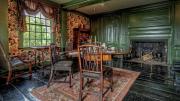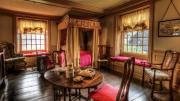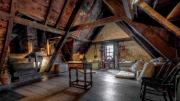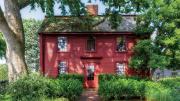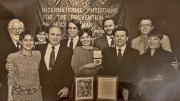The House of the Seven Gables, in Salem, Massachusetts, would not be the popular incarnation of Nathaniel Hawthorne’s 1851 gothic tale of inherited sins if not for philanthropist Caroline Osgood Emmerton. In 1908 she bought the harbor-side property to shrewdly combine her two principal causes: historic preservation and social welfare.
She hired Colonial Revivalist architect Joseph Everett Chandler, fresh from his work on the Paul Revere House in Boston, to help her save the 1668 timber-frame structure, then known as the Turner-Ingersoll Mansion, from being demolished. They restored it—replacing four gables, the central chimney, and added the “secret staircase”—to reflect some features described by the Salem-born author, who had presumably visited the house when it was owned by his relatives, the Ingersolls. Notably, they also created the fictional Hepzibah Pyncheon’s Cent Shop on the first floor, which never existed outside Hawthorne’s imagination.
The house museum opened for public tours in 1910, and Emmerton funneled the admissions fees into a settlement house, offering educational and social services, inspired by those established decades earlier in Chicago and London. “The historical and literary associations of the old houses,” she wrote in her one published work, The Chronicles of Three Old Houses (1935), “must surely help in making American citizens of our boys and girls.”
Today’s visitors to the site can learn not only about Hawthorne’s provocative perspective on American history and an emerging national character, but also about the social changes wrought by industrial forces in the early twentieth century.
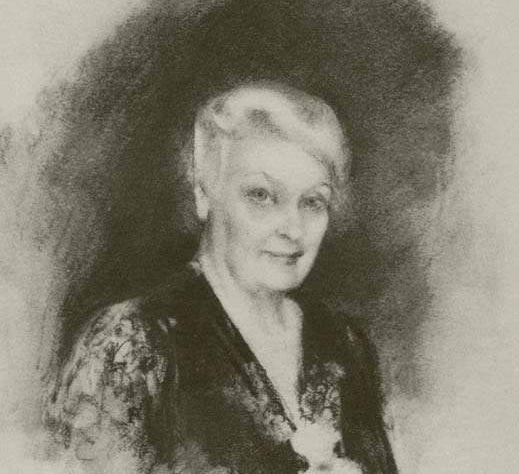
A sketch of Caroline Emmerton in her later years, by an unknown artist
Photograph courtesy of the House of the Seven Gables
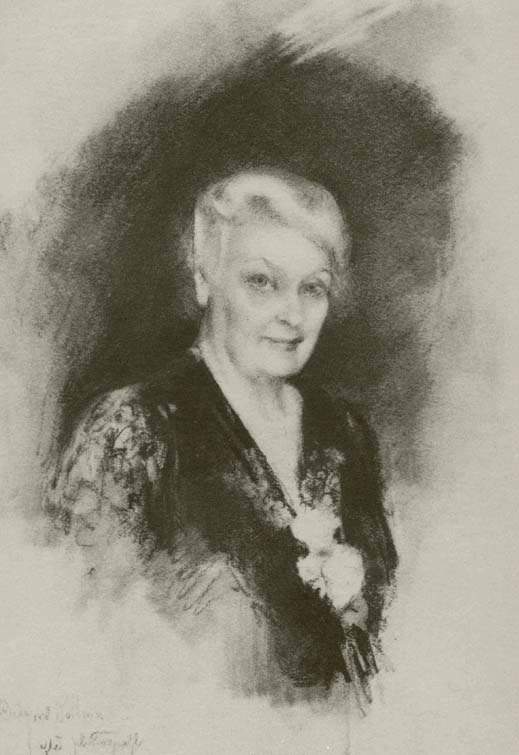
A sketch of Caroline Emmerton in her later years, by an unknown artist
Photograph courtesy of the House of the Seven Gables
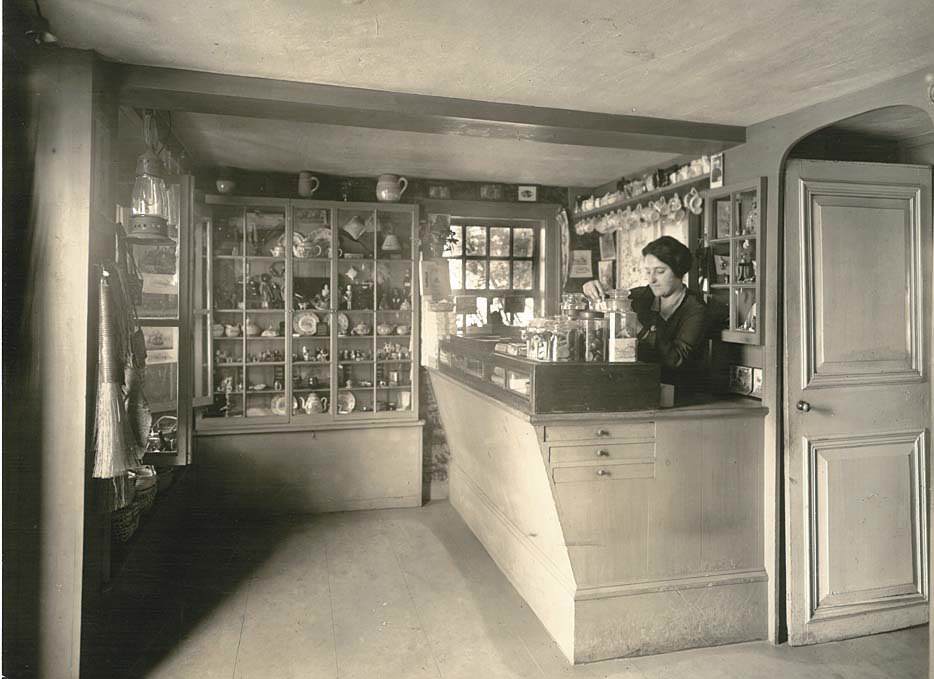
The Gables’ Cent Shop (above) around 1910, when the museum opened
Photograph courtesy of the House of the Seven Gables
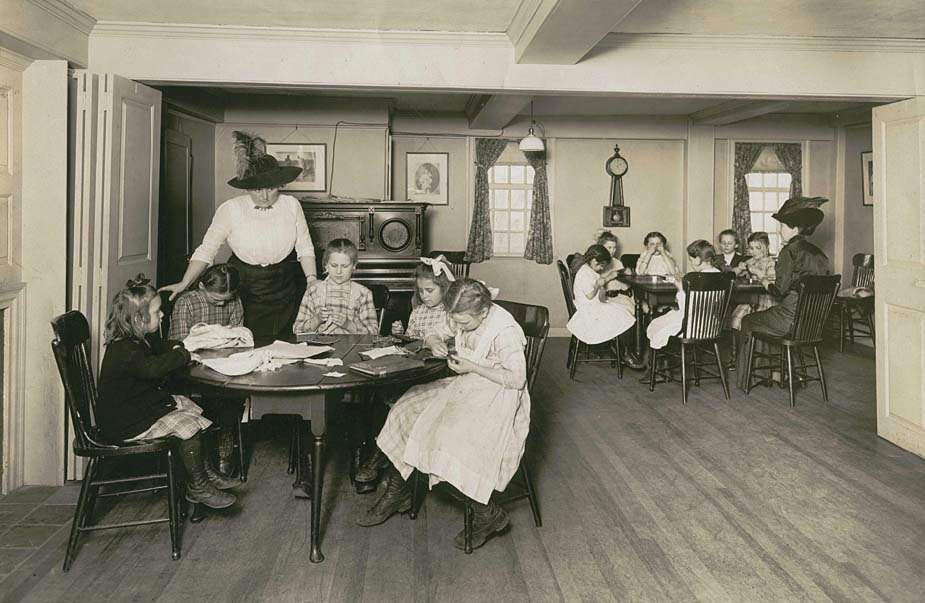
Emmerton (standing, at left) during a needlework class at the Seamen’s Bethel
Photograph courtesy of the House of the Seven Gables
Now owned by the nonprofit House of the Seven Gables Settlement House, the trust Emmerton set up before she died in 1942, the two-and-a-half–acre property has expansive views of the harbor and is open year-round. The Gables house itself represents more than three centuries of architectural styles and history, and six other buildings on the grounds date from 1655 to roughly 1830.
The Hooper-Hathaway House (1682) and Retire Beckett House (1655), now used as a gift shop, were moved there and restored by Emmerton. The Nathaniel Hawthorne Birth Home (c. 1750), where he lived until 1808, was added in 1958. There is a 45-minute guided tour of the Gables, and visitors are free to roam the birthplace, which features the only extant portrait of Hawthorne’s father (a sea captain who died when the author was three), first editions of his books and pages from a few manuscripts, artwork by his wife, Sophia Peabody, and the desk on which he wrote The Scarlet Letter and The House of the Seven Gables. Staff are on hand to talk about Hawthorne, his life and literary legacy—and about Salem’s multifarious past. The seaside lawn and abundant historic gardens include the central Jacobean-knot-style planted beds, designed and laid out by Chandler in 1909, and a wisteria arbor added in the 1920s.
Built by Captain John Turner in 1668, the Gables was soon expanded to 14 rooms—thus becoming one of the grandest homes in the region at the time. It is now the only wooden house of its size and age to survive in the United States. (The association is raising funds to refurbish two long-unused rooms on the second floor that feature the original wide-pine-plank floors, hand-forged nails, and an exposed gunstock post.)
This year also marks Emmerton’s 150th birthday. A special exhibit of photographs and artifacts “Caroline Emmerton: An Unbounded Vision," is on display through August 31; a series of lectures, concerts, and performances is also planned. “She was truly a visionary,” says Emmerton researcher David Moffat, a lead tour guide at the Gables. “She best embraced the progressive spirit of the early twentieth century because she was looking at the problems of industrialization and immigration and came to the unique, two-fold mission for the House of the Seven Gables.”
Born in 1866 to a wealthy, civic-minded family, Emmerton counted among her ancestors John Bertram, who sponsored Salem’s first hospital, and whose Essex Street home ultimately became the public library. Her mother, Jennie Bertram Emmerton, was also a force, especially with the Old Ladies’ Home and the Salem Society for Higher Education for Women. The city Emmerton grew up in, however, was transitioning from a shipping stronghold to a manufacturing center, Moffat says; she would have witnessed the evolving industrialization, and the second wave of immigrants who moved to the city seeking jobs in the textile, leather, and other factories.
By 28, Emmerton was holding her own as an elected board member of the Salem Seamen’s Orphan and Children’s Fund Society. In the years leading to her purchase of the Turner-Ingersoll Mansion, she was also involved with the Seamen’s Bethel House. (She eventually bought that “ugly” building, which blocked the mansion’s harbor views, and moved it down the street to use for settlement house “dramatics, athletics, dances, concerts, fairs, etc.”) In 1910, while at work on transforming the Gables, she and her friend Aroline Gove (daughter of another strong woman, the entrepreneurial manufacturer of women’s herbal remedies Lydia Pinkham) made history as the first women appointed as trustees of Salem’s Plummer Home for Boys, reports former Gables researcher Irene Axelrod, who has studied Emmerton.
“I have a great deal of admiration for her,” Axelrod says. “There’s also a bit of a mystery”—surprising for someone so accomplished. Emmerton left no known personal papers—journals, letters, or notes—nor any business-related records, she explains; only a few images of her exist, and “there are also no romantic relationships I’ve ever seen any sign of, and no children. She was educated, but we don’t know where or how exactly.” The Chronicles details only her conservation efforts at the Gables complex. The association’s archives do hold a few scripts for plays and pageants that she wrote for settlement productions—she was a talented writer, fundraiser, and delegator, according to Axelrod—along with several handwritten speeches and essays.
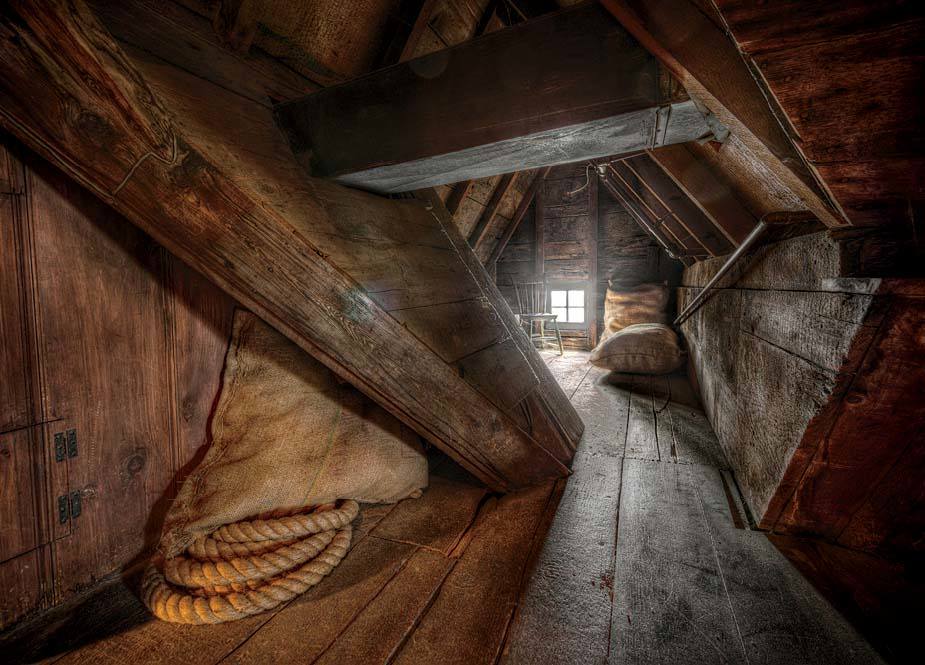
A “secret staircase” leads to the attic at the House of the Seven Gables, in Salem, Massachusetts.
Frank C. Grace, Trig Photography
One text from 1919 focuses on social reform and reveals a progressive’s viewpoint in typically “stark, moral terms,” asserts Moffat. “Life in America had been shamefully materialized before the war,” Emmerton wrote. “The passion for money-getting in men which had numbed other spiritual fibre, had permeated the whole nation and had ensured widespread industrial discontent and jealousy.” Some of her views “are antiquated in terms of the Americanization of immigrants,” Moffat acknowledges. “But I do think that she did have the best interest, or what she thought was the best interest, of people in Salem at heart. She was interested in improving their lives and this was foremost in her whole life.”
By 1910 Emmerton was a leader of a group of women who had already begun offering classes in handicrafts, dancing, and “gymnasium work” at the Salem YMCA to serve the city’s eastern European immigrants. She would greatly expand those programs in the re-sited Seamen’s Bethel building and in the Hooper-Hathaway House, a bakery she moved to the Gables site, restored, and rechristened in 1911.
Within two years, Axelrod notes, the settlement house’s annual report listed “eight clubs for boys, three for girls, a mother’s group, a men’s club, as well as classes in cooking, housekeeping, dressmaking, dancing, dramatics, nursing, sewing, embroidery, laundry work, as well as manual training for boys. Storytelling and gymnastics, a small library, a garden club and summer camp were also available.” The settlement workers, who lived primarily on the second floor of the Gables, were among the new crop of college-educated women for whom Emmerton conscientiously provided jobs.
Axelrod interviewed some of the last people to know Emmerton, including the last settlement worker to live at the Gables. (Settlement work persisted in varying forms, first on the site and then in a building across the street, now called Emmerton Hall, until 2010, and is now conducted through partnerships with local nonprofit service organizations.) From these oral histories, the philanthropist emerges as a tall, fleshy woman (she had a customized bath tub) with a commanding personality, both exacting and generous. On her daily visits to the Gables, she was known to correct the tour guides, even mid-spiel, if they made mistakes. “Mrs. Emmerton…did like things done as she directed,” Mary Burke, who worked at the Gables from 1937 to 1985, told Axelrod, but she “was quite approachable. She also noticed when anything in the house or the grounds had been moved or changed…and would immediately put things back in their original places.”
If reports that small children were intimidated by her size (and perhaps by the ornate hats she favored) are true, Axelrod says their mothers probably were not. They were treated to rides in Emmerton’s limousine.
Her circle of friends included pioneering New England preservationists such as William Sumner Appleton, A.B. 1892, who founded the Society for the Preservation of New England Antiquities (now Historic New England) in 1910. He recruited her as a board member, and also prompted her to safeguard the Hooper-Hathaway House. The Chronicles of Three Houses recounts Emmerton’s own careful research into the histories of that house and of the Retire Beckett House (named for a prominent early Salem shipbuilder, and moved to the site in 1924), and details her use of Hawthorne’s novel as a guide to restoring the Gables.
The “original” house, according to the novel, was a “family-mansion, spacious, ponderously framed of oaken timber, and calculated to endure for many generations of his posterity: a rusty wooden house, with seven acutely peaked gables facing towards various points of the compass, and a huge, clustered chimney in the midst.” In fact, Turner could exit the front door and walk to the sea wall to view his wharf and five-ship fleet that contributed to the Caribbean trade in sugar and molasses and his role in the distillation of “strong waters.” He died 12 years after building the house, leaving his widow, Elizabeth Turner, pregnant with their fifth child and four others under the age of 10; she raised the children and ran the household and the shipping business until remarrying.
By 1782, Turner’s grandson had lost the family fortune and the mansion was bought at auction by sea captain Samuel Ingersoll, a merchant in the burgeoning spice trade with Indonesia and southern China. He modernized it, removing four gables to better conform to the boxier, Federal-style architecture of the day, and updated the interior, although he kept the high-style Georgian wood-paneled walls in the parlor and “Great Chamber.”
His daughter, Susanna Hathorne Ingersoll, was Nathaniel Hawthorne’s second cousin (the author added the “w” after publishing his early stories). Inheriting the property in 1811, she fought relatives to keep it, barricading herself inside and ultimately taking legal action. She also refused four marriage proposals and became a wealthy real-estate agent. According to Emmerton’s book, she “was a tall, stately young woman, fond of society, so it is said, until an unfortunate love affair with a naval officer, who sailed away, turned her into a recluse and more or less of a man hater.”
Despite gossip that Ingersoll refused to allow a man on the premises, Emmerton surmises that she entertained Hawthorne, 20 years her junior, and relayed the home’s history. He could have visited as a child and after graduating from Bowdoin College, and then again when he moved back to Salem in 1847 with his wife and son.
When Susanna Ingersoll died, the Gables passed to her foster son, Horace Lorenzo Conolly, who lost it to creditors in 1879. The theatrical Upton family then owned it for decades. They put on plays and dances and even opened a few rooms as a “museum.” (It might have included the “secret staircase” they reportedly told Emmerton they had discovered when they removed the central chimney, but Moffat says no structural evidence proves it was ever there, and Hawthorne doesn’t refer to it in his novel.) Emmerton had always been intrigued by the home’s colorful past, and visited the Uptons, probably going to or from her volunteer work at the Seamen’s Bethel.
She wrote that she first visited the mansion “with a party of young people” soon after Conolly had moved out: “I well remember the thrill the gaunt old house gave me.” The rooms were empty, the walls stark, and walking into the attic (where indentured servants and then slaves had lived in earlier days), she saw “sketchy outlines of two vanished gables on the sloping walls…like shadowy ghosts haunting the scene of their past life.” Consciously or not, she echoes one of Hawthorne’s opening passages describing what amounts to his muse: “The aspect of the venerable mansion has always affected me like a human countenance, bearing the traces not merely of outward storm and sunshine, but expressive also of the long lapse of mortal life, and accompanying vicissitudes that have passed within.”

